Bratislava (Pozsony in Hungarian, Pressburg in German), is the capital and largest city in Slovakia. It has a population of almost 415,000 and is the administrative, cultural and economic centre of the country. Before 1919, it was known as Prešporok in Slovak.
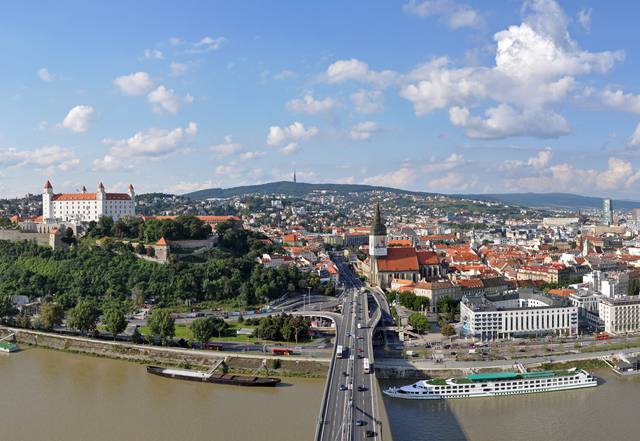
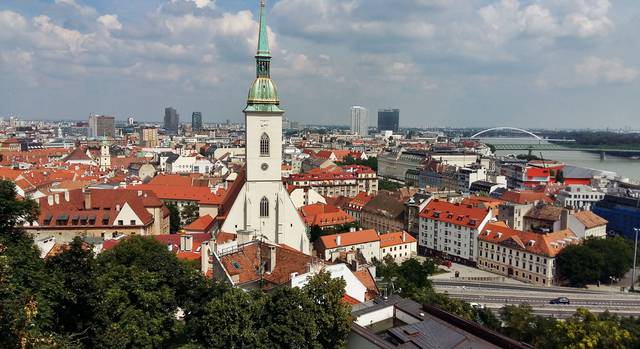 Bratislava has a very pleasant medieval inner city with narrow, winding streets, a hill-top castle next to the river Danube, and many historic churches and buildings to visit. The old town is centered on two squares, Hlavne namestie (main square) and Hviezdoslavovo namestie (Hviezdoslav square, named after a famous Slovak poet). Of a rather different architectural character are some of the communist-era buildings found in the modern parts of the city; a prime example is Petrzalka housing estate, the biggest Communist-era concrete block housing complex in Central Europe, which stretches on endlessly just across the river. Move further east and there are plenty of rural places to explore. There are farms, vineyards, agricultural land, and tiny villages less than 50 km to the north and east of Bratislava.
Bratislava has a very pleasant medieval inner city with narrow, winding streets, a hill-top castle next to the river Danube, and many historic churches and buildings to visit. The old town is centered on two squares, Hlavne namestie (main square) and Hviezdoslavovo namestie (Hviezdoslav square, named after a famous Slovak poet). Of a rather different architectural character are some of the communist-era buildings found in the modern parts of the city; a prime example is Petrzalka housing estate, the biggest Communist-era concrete block housing complex in Central Europe, which stretches on endlessly just across the river. Move further east and there are plenty of rural places to explore. There are farms, vineyards, agricultural land, and tiny villages less than 50 km to the north and east of Bratislava.
Bratislava and its surroundings form the second-most prosperous region in Central and Eastern Europe, with a per capita GDP of around 167% of the EU-27 average. Bratislava is the sixth richest region of the European Union, and GDP per capita is about three times higher than in other Slovak regions
-cEZQv.medium.jpg) After the fall of the Great Moravian Empire, Slovakia became part of the Kingdom of Hungary from the 10th century (later included with the Austro-Hungarian Empire) until the end of the First World War. The city was the capital (1536-1784), the coronation city (1563-1830), and the seat of the Diet (1536-1848) of the Kingdom of Hungary for three centuries. In this period, eleven Hungarian kings and queens were crowned at St. Martin's Cathedral. At that time, the city was called Preßburg in German and Pozsony in Hungarian, and had a clear German (42%) and Hungarian (40%) ethnic majority (1910 census). In 1919, the Treaty of Trianon created Czechoslovakia, and Bratislava was attached to the newly founded state. In the same year, the name Bratislava was officially adopted for the first time.
After the fall of the Great Moravian Empire, Slovakia became part of the Kingdom of Hungary from the 10th century (later included with the Austro-Hungarian Empire) until the end of the First World War. The city was the capital (1536-1784), the coronation city (1563-1830), and the seat of the Diet (1536-1848) of the Kingdom of Hungary for three centuries. In this period, eleven Hungarian kings and queens were crowned at St. Martin's Cathedral. At that time, the city was called Preßburg in German and Pozsony in Hungarian, and had a clear German (42%) and Hungarian (40%) ethnic majority (1910 census). In 1919, the Treaty of Trianon created Czechoslovakia, and Bratislava was attached to the newly founded state. In the same year, the name Bratislava was officially adopted for the first time.
Between 1939 and 1944, Slovakia was a Nazi puppet state. In 1941–1942 and 1944–1945, this government collaborated in deporting most of Bratislava's approximately 15,000 Jews to concentration camps, where most were murdered. Bratislava was occupied by German troops in 1944, and eventually taken by the Soviet Red Army on 4 April 1945, after a failed insurrection of Slovak partisans, now commemorated as Slovenské národné povstanie, or "Slovak National Uprising".
After the Communist Party seized power in Czechoslovakia in February 1948, the city witnessed profound demographic and urban transformation. In 1969 it became the capital city of the Slovak Socialist Republic, one of the two component states of federal Czechoslovakia.
Bratislava's dissidents anticipated the fall of Communism with the Bratislava candle demonstration in 1988, and the city became one of the foremost centres of the anti-Communist "Velvet Revolution" in 1989. In 1993, the city became the capital of the newly formed Slovak Republic following the "Velvet Divorce".
Since the fall of the Iron Curtain and especially with the accession of Slovakia to the European Union (May 2004) and later the Schengen Area, Bratislava is often marketed together with Vienna as "twin cities" due to their closeness. They are the two European capitals with the shortest distance to one another and should you ever get bored with Bratislava, Vienna is certainly an interesting day trip. You can even cross the roughly 60 km of distance on a bike in a single day if you're moderately fit.
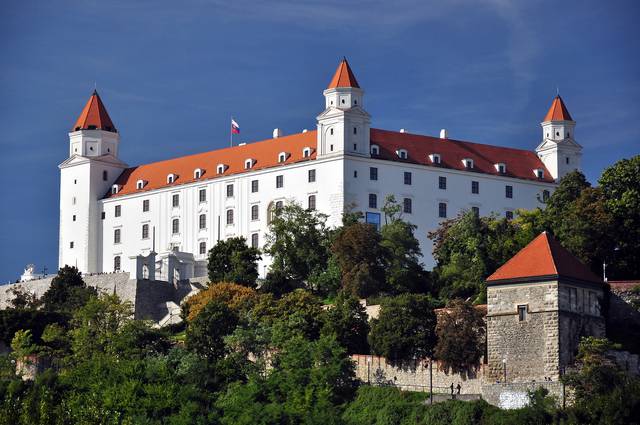
- Bratislava Castle, +421 2 54411444. Tu-Su 10:00-18:00. The castle has reopened after reconstruction and hosts exhibitions. There is also a restaurant at the castle open till after the actual castle tours into the night. Adult €10.

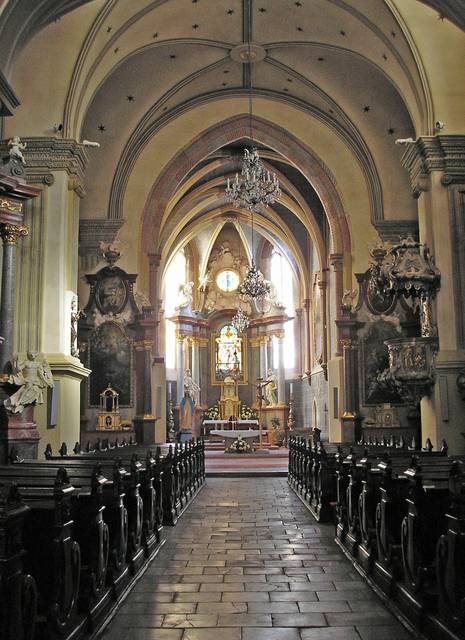 For museum-goers, Bratislava is the place to go, with some bigger and loads of small museums around town. Every year in the weekend around 24 April Bratislava celebrates a festival called "Bratislava for All", giving locals and visitors the possibility to visit most of the facilities governed by the city for free or a reduced fee, this including most of the museums and galleries. In May, the city's museums and galleries keep their gates open to visitors until late at night, this being called the "Night of Museums and Galleries".
For museum-goers, Bratislava is the place to go, with some bigger and loads of small museums around town. Every year in the weekend around 24 April Bratislava celebrates a festival called "Bratislava for All", giving locals and visitors the possibility to visit most of the facilities governed by the city for free or a reduced fee, this including most of the museums and galleries. In May, the city's museums and galleries keep their gates open to visitors until late at night, this being called the "Night of Museums and Galleries".
- Pharmacological Museum.
- Slovak National Gallery (SNG). For a taste of visual arts, pay a visit to the National Gallery at the embankment between Starý most and Nový most with permanent collections of Slovak and European medieval art pieces, although the temporary exhibitions tend to be far more interesting.
- Bratislava City Gallery (GMB). Bratislava City Gallery is also a good pick to see displays of historical fine arts, paintings and sculptures along with interesting temporary exhibitions.
- Danubiana Art Museum. If you like modern art better, pay a visit to the Danubiana Art Museum on the southern edge of Bratislava but be aware that it is too far for a stroll, with little to no public transport connections, and is best reached by car or taxi.
- Milan Dobes Museum. This small museum features modernist Op-art. It lies in the city center and is recommended to all interested in the development of modern art.
- National Museum, Žižkova 14 (At the foot of Castle Hill, +421 2 59207273. Permanent archaelogical collections.
- Bratislava City Museum.
- Natural Science Museum, Vajanského nábrežie 2, +421 2 59349122. Echoing the communist era, the natural science exhibitions have an interesting collection of artifacts and is slowly being transformed into a modern era exhibition.
- Gerulata, Gerulatska ul.. This is an ancient Roman military camp with archeological findings on display. If you're into all things Roman, you should also consider a visit to the nearby Carnuntum which has a large archeological site and is a few minutes by car from Bratislava.
- Museum of Transport, Šancová 1/a, +421 2 52444163. With a display of historical vehicles in the first railway station in the city, very close to the current Main Railway Station.
- Museum of Trade, Linzbothova 16, +421 2 45243167. This museum has some remarking pieces of historic advertising plates and other artifacts.
- Jewish Community Museum, Heydukova 11-13, +421 2 5441 6949. Rare Jewish ritual tools, gold-embroidered mantles protecting the holy biblical scrolls, unique photographs of students who had attended the famed Bratislava rabbi school that reveal even to this day the atrocities of the Holocaust. It is situated in the Heydukova Street Synagogue, which is the only synagogue in Bratislava. Constructed in 1923-1926, it is a Cubist building designed by the Bratislava-based Jewish architect Artur Szalatnai-Slatinský and is listed as a national cultural monument. Orthodox in orientation, the synagogue still serves as an active Jewish house of worship. The Jewish Community Museum with a permanent exhibition “The Jews of Bratislava and Their Heritage” is installed upstairs and during the summer season is open to the public up till September, every Friday 13:00 till 16:00 and every Sunday 10:00-13:00.
- Museum of City History, +421 2 59205130. Tu-F 10:00–17:00, Sa Su 11:00–18:00. Including the museums of history and music as well as the city dungeon and the exhibition on medieval justice. €5.
Pharmacological Museum.
Slovak National Gallery (SNG). For a taste of visual arts, pay a visit to the National Gallery at the embankment between Starý most and Nový most with permanent collections of Slovak and European medieval art pieces, although the temporary exhibitions tend to be far more interesting.
Bratislava City Gallery (GMB). Bratislava City Gallery is also a good pick to see displays of historical fine arts, paintings and sculptures along with interesting temporary exhibitions.
Danubiana Art Museum. If you like modern art better, pay a visit to the Danubiana Art Museum on the southern edge of Bratislava but be aware that it is too far for a stroll, with little to no public transport connections, and is best reached by car or taxi.
Milan Dobes Museum. This small museum features modernist Op-art. It lies in the city center and is recommended to all interested in the development of modern art.
National Museum, Žižkova 14 (At the foot of Castle Hill, +421 2 59207273. Permanent archaelogical collections.
Bratislava City Museum.
Natural Science Museum, Vajanského nábrežie 2, +421 2 59349122. Echoing the communist era, the natural science exhibitions have an interesting collection of artifacts and is slowly being transformed into a modern era exhibition.
Gerulata, Gerulatska ul.. This is an ancient Roman military camp with archeological findings on display. If you're into all things Roman, you should also consider a visit to the nearby Carnuntum which has a large archeological site and is a few minutes by car from Bratislava.
Museum of Transport, Šancová 1/a, +421 2 52444163. With a display of historical vehicles in the first railway station in the city, very close to the current Main Railway Station.
Museum of Trade, Linzbothova 16, +421 2 45243167. This museum has some remarking pieces of historic advertising plates and other artifacts.
Jewish Community Museum, Heydukova 11-13, +421 2 5441 6949. Rare Jewish ritual tools, gold-embroidered mantles protecting the holy biblical scrolls, unique photographs of students who had attended the famed Bratislava rabbi school that reveal even to this day the atrocities of the Holocaust. It is situated in the Heydukova Street Synagogue, which is the only synagogue in Bratislava. Constructed in 1923-1926, it is a Cubist building designed by the Bratislava-based Jewish architect Artur Szalatnai-Slatinský and is listed as a national cultural monument. Orthodox in orientation, the synagogue still serves as an active Jewish house of worship. The Jewish Community Museum with a permanent exhibition “The Jews of Bratislava and Their Heritage” is installed upstairs and during the summer season is open to the public up till September, every Friday 13:00 till 16:00 and every Sunday 10:00-13:00.
Museum of City History, +421 2 59205130. Tu-F 10:00–17:00, Sa Su 11:00–18:00. Including the museums of history and music as well as the city dungeon and the exhibition on medieval justice. €5.
- St. Martin's Cathedral. Nov-Mar: M-Sa 09:00-11:30, 13:00-16:00, Su 13:30-16:00; Apr-Oct: Mon-Sa 09:00-11:30, 13:00-18:00, Su 13:30-16:00. The largest and one of the oldest churches in Bratislava, situated below Bratislava Castle. The Gothic cathedral, formerly the coronation-church of several Hungarian kings, begun in 1204, and reconsecrated in 1445, was restored in 1861-80. The tower is surmounted by a pyramid bearing a gilded Hungarian royal crown. Entrance €2.
- St. Clare's Church. A Gothic church on Klariská street, in the historical center; now used as a concert hall.
- Church of the Annunciation.
- Church of the Holy Savior.
- Church of St. Elisabeth. Nicknamed the Blue Church (Modrý kostolík), this is a beautiful Jugendstil church finished in 1913.
- Trinitarian Church of Bratislava. free.
St. Martin's Cathedral. Nov-Mar: M-Sa 09:00-11:30, 13:00-16:00, Su 13:30-16:00; Apr-Oct: Mon-Sa 09:00-11:30, 13:00-18:00, Su 13:30-16:00. The largest and one of the oldest churches in Bratislava, situated below Bratislava Castle. The Gothic cathedral, formerly the coronation-church of several Hungarian kings, begun in 1204, and reconsecrated in 1445, was restored in 1861-80. The tower is surmounted by a pyramid bearing a gilded Hungarian royal crown. Entrance €2.
St. Clare's Church. A Gothic church on Klariská street, in the historical center; now used as a concert hall.
Church of the Annunciation.
Church of the Holy Savior.
Church of St. Elisabeth. Nicknamed the Blue Church (Modrý kostolík), this is a beautiful Jugendstil church finished in 1913.
Trinitarian Church of Bratislava. free.
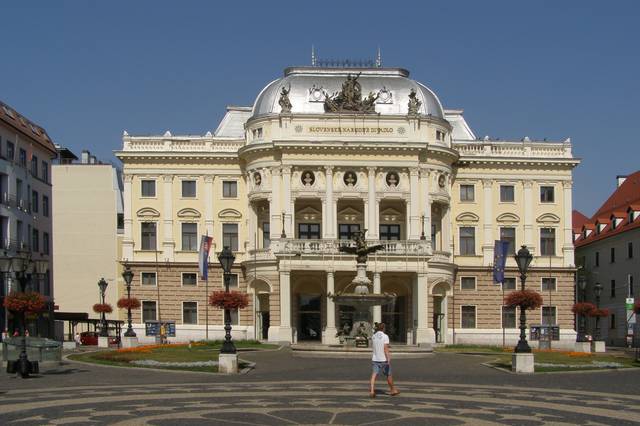
- Primate's Palace. Now the seat of the Mayor of Bratislava.
- Old Town Hall, Primaciálne square 3 (next to Primate's Palace. The Old Town Hall is open to the public as a museum.
- Grassalkovich Palace and gardens. Or the Presidential Palace (Prezidentský palác) - a Rococo/late Baroque summer palace with a French garden, used as a seat of the President of Slovakia. In one of the garden's alleys you will see a row of trees planted by famous people such as Juan Carlos I (King of Spain). In front of the Palace you will see the Slovak National Guard.
- Mirbach Palace.
- Palffy Palace.
- Academia Istropolitana. The oldest historic university in the area, which is now occupied by the state of Slovakia, from the 13th century.
- Slovak National Theatre, Hviezdoslavovo square. The historic building of the Slovak National Theatre, built in 1886.
- Slovak Radio Building. Its main building is a peculiar 60-m-high reversed pyramid from the communist era and a landmark in sharp contrast with the building of the Slovak National Bank just across the street.
Primate's Palace. Now the seat of the Mayor of Bratislava.
Old Town Hall, Primaciálne square 3 (next to Primate's Palace. The Old Town Hall is open to the public as a museum.
Grassalkovich Palace and gardens. Or the Presidential Palace (Prezidentský palác) - a Rococo/late Baroque summer palace with a French garden, used as a seat of the President of Slovakia. In one of the garden's alleys you will see a row of trees planted by famous people such as Juan Carlos I (King of Spain). In front of the Palace you will see the Slovak National Guard.
Mirbach Palace.
Palffy Palace.
Academia Istropolitana. The oldest historic university in the area, which is now occupied by the state of Slovakia, from the 13th century.
Slovak National Theatre, Hviezdoslavovo square. The historic building of the Slovak National Theatre, built in 1886.
Slovak Radio Building. Its main building is a peculiar 60-m-high reversed pyramid from the communist era and a landmark in sharp contrast with the building of the Slovak National Bank just across the street.
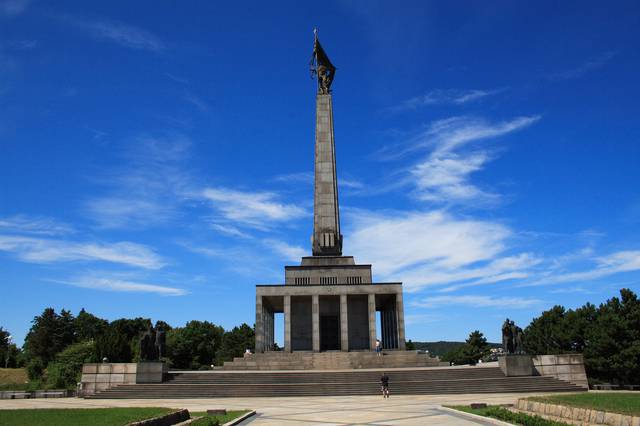
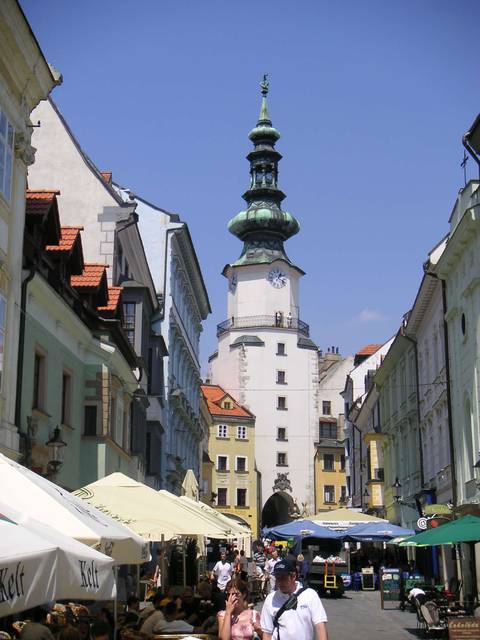
- Slavín monument. On the top of the hill behind the castle, overlooking the entire city. This is a monument in memory of Soviet casualties in the liberation battle of Bratislava in World War II. It is the highest place in the city, and thus the best place for viewing the city. Slavin is a cemetery and thus rather quiet. On warm nights it's a very romantic place, allowing you to sit in the shadows of the monument and look at the traffic below. To get there, take trolleybus no. 203 from Hodžovo námestie (in front of the Presidential Palace) in the direction Búdková and get off in 9 minutes at the last stop, then walk 500 m along Stará vinárska and then Pažického streets. Slavin is near an embassy district.
- Roland Fountain. Built by stone cutter Andreas Luttringer and commissioned by Hungarian king Maximilian in 1527, this was the first fountain in Bratislava.
- Michael's Gate with Tower. This 51-m-high tower above the gate with its green copper roof is one of the best known and the oldest buildings in Bratislava. It was built in the 14th century as one of the four gates to the city.
- Laurin's Gate.
- Chatam Sofer Mausoleum.
- Jewish Cemetery, Jewish Community Museum and Bratislava Synagogue, Heydukova. The only synagogue in Bratislava.
Slavín monument. On the top of the hill behind the castle, overlooking the entire city. This is a monument in memory of Soviet casualties in the liberation battle of Bratislava in World War II. It is the highest place in the city, and thus the best place for viewing the city. Slavin is a cemetery and thus rather quiet. On warm nights it's a very romantic place, allowing you to sit in the shadows of the monument and look at the traffic below. To get there, take trolleybus no. 203 from Hodžovo námestie (in front of the Presidential Palace) in the direction Búdková and get off in 9 minutes at the last stop, then walk 500 m along Stará vinárska and then Pažického streets. Slavin is near an embassy district.
Roland Fountain. Built by stone cutter Andreas Luttringer and commissioned by Hungarian king Maximilian in 1527, this was the first fountain in Bratislava.
Michael's Gate with Tower. This 51-m-high tower above the gate with its green copper roof is one of the best known and the oldest buildings in Bratislava. It was built in the 14th century as one of the four gates to the city.
Laurin's Gate.
Chatam Sofer Mausoleum.
Jewish Cemetery, Jewish Community Museum and Bratislava Synagogue, Heydukova. The only synagogue in Bratislava.
- SNP Bridge. A bridge over the Danube river, with its flying saucer-shaped structure housing a restaurant called "UFO". There is an observation deck on its roof, open from 10:00-23:00 daily, offering great views of the old town, as well as the apartment blocks in Petržalka. Entrance €6.50, but is free of charge if you eat in the restaurant.
- Main Indoor Market.
SNP Bridge. A bridge over the Danube river, with its flying saucer-shaped structure housing a restaurant called "UFO". There is an observation deck on its roof, open from 10:00-23:00 daily, offering great views of the old town, as well as the apartment blocks in Petržalka. Entrance €6.50, but is free of charge if you eat in the restaurant.
Main Indoor Market.
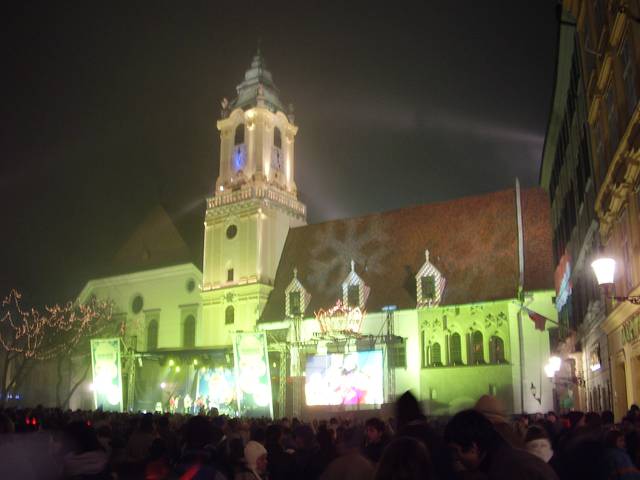
Take a stroll through the centre of the town. Bratislava has one of the smallest historical centers around but the charm is more concentrated. The streets have been completely renovated over the last ten years, bringing life back here. Since then a multitude of cafes, bars and restaurants of all kinds have opened here, accompanied by a few souvenir shops and fashion stores. On warm days almost every cafe has an outdoor seating section in the street, bustling with life and giving the city a unique cozy feeling.
When it comes to sightseeing, Bratislava Castle generally is a must and is already opened after the reconstruction. You can visit also Slavin memorial for some really astounding views of the city. It's a calm and romantic spot but beware, it can get really windy up there. The City Museum located in the Old Town Hall offers visitors climbing up the steep stairwells of the clock tower or seeing the town's historical dungeons, an exhibition that was quite outdated but still scary in 2008.
In summer, you can also visit Bratislava Zoo, providing a nice walk between the animal enclosures, the latest addition being some rare white tigers. The facilities of the zoo are slowly being renovated to attract more visitors and the zoo is a favourite for families on sunny days. You can also go to the Botanical Gardens of Comenius University (Botanická 3, take tram X6 to stop Botanická záhrada) for quiet and peaceful strolls in this green space. There are also several lakes opened for bathing. The biggest and probably the most famous lake is called Zlaté piesky (Golden Lakes) or Vajnorské jazerá, known as Bager lake (the later is used for bating only unofficially).
For a relaxed afternoon in the park, head either to Sad Janka Kráľa park (on the right bank of the river Danube and next to Aupark shopping centre), the oldest public park in central Europe, relax at the embankments on both sides of the river or head to Horský park (Forest Park) north off Slavin memorial for a civilized stroll through the forest. There's a small café here as well as a pub, the latter mostly populated by students from the nearby campus. For a more outdoorsy experience, hop on bus No 203/213 to Koliba and walk up to Kamzík (takes about 30 minutes uphill) or try the newly renovated facilities of Partizánska lúka and Snežienka, all with extensive picknicking areas and loads of fireplaces for grilling. The area is several kilometers long and you can either walk here from the terminal station of bus No 212 (Vojenska nemocnica) or take a bus to Patronka and use bus No 43 driving up the area and back every 15–30 minutes (depending on time of day/year as well as weather). Only cars with a permit can enter the area but there is a parking lot at the entrance, close to a bus stop. Snezienka's grass fields and the top of Kamzik hill are connected with a chairlift, operating Thursdays through Sundays and on holidays, the price for one ride being approx. €3.
In December, be sure to indulge in the scents and flavours of the traditional Christmas Market in front of Old Town Hall and on the Hlavne namestie (main square). The market - compared to the ones in Prague and Vienna - is smaller, but has a much friendlier, almost family-like atmosphere and feels much more traditional and less overtly commercialized than others in the region. The people of Bratislava love to meet here for a drink and a bite to eat; try the 'varene vino' (mulled wine).
- Speedboats.sk, Kúpeľná 6, +421 903 610 716. Enjoy the beautiful view of Bratislava and the surrounding nature of the river Danube during a Bratislava boat trip.
- Bratislava Free Tour. Free walking tour covering the city's sights, culture & history. Every day at 11:00 and 15:00.
Bratislava is the home of the world famous Slovak Philharmonic Orchestra so if you love classical music, you should consider attending one of the concerts in the historic Reduta building. For more cultural indulgence, the Slovak National Theatre offers a wide selection on ballet, opera and theatre performances. Although most of the activities have been moved to a city-district-in-the-making on the banks of the Danube, some performances are still being held in the historical theatre building, which gives them a unique feeling but a higher price tag as well. The old theatre building is right in the middle of the city at Hviezdoslavovo namestie. The new theatre is accessible by bus No 88 from the Coach Terminal at Mlynske nivy (get off at Landererova) or by buses No 50, 70 and 78 (stop is called Wüstenrot). None of these stop directly at the theatre though, so you should count on a 5-10 minute walk from the bus stop to the theatre. You cannot miss the building as it is of unmistakably communist megalomaniac design covered in white marble. The entrance is facing the Danube so you need to walk around the building to get in.
- Watch football ie soccer at SK Slovan Bratislava, who play in Slovak Super Liga, the country's top tier of football. Their home ground is Pasiensky, capacity 11,600, 2 km northeast of the old city centre.
- Ice hockey is the national sport of Slovakia. The local hockey team, HC Slovan Bratislava, plays games frequently throughout each year beginning in September and concluding in the spring of the following year. Since this team plays in KHL league, even more Slovaks started visiting its matches. Home games are played at Ondrej Nepela Arena stadium, Odbojárov 9. Many Slovaks are passionate about both watching and playing ice hockey. The stadium can be reached easily by public transport.
- Adventure sports: Bungee jumping from the Lafranconi bridge has become very popular among Slovaks as well as tourists in the last couple of years. Another popular activity among locals and tourists especially during a stag party is target shooting in Bratislava and its near vicinity. For some extreme adventure in the pure nature Slovaks and visitors can try to sail the river Small Danube in a canoe. Water sports in general are among the most beloved sports activities with many successful sportsmen such as the Hochschorner brothers.
Watch football ie soccer at SK Slovan Bratislava, who play in Slovak Super Liga, the country's top tier of football. Their home ground is Pasiensky, capacity 11,600, 2 km northeast of the old city centre.
Ice hockey is the national sport of Slovakia. The local hockey team, HC Slovan Bratislava, plays games frequently throughout each year beginning in September and concluding in the spring of the following year. Since this team plays in KHL league, even more Slovaks started visiting its matches. Home games are played at Ondrej Nepela Arena stadium, Odbojárov 9. Many Slovaks are passionate about both watching and playing ice hockey. The stadium can be reached easily by public transport.
Adventure sports: Bungee jumping from the Lafranconi bridge has become very popular among Slovaks as well as tourists in the last couple of years. Another popular activity among locals and tourists especially during a stag party is target shooting in Bratislava and its near vicinity. For some extreme adventure in the pure nature Slovaks and visitors can try to sail the river Small Danube in a canoe. Water sports in general are among the most beloved sports activities with many successful sportsmen such as the Hochschorner brothers.
Over the last two decades, many foreigners have been moving to Bratislava to study and work at the many international companies that created new jobs. After work, many expatriates and their Slovak friends hang out at casual events where everybody speaks English and enjoys the evening together. For travelers to Bratislava, joining these usually free events is an excellent and fun opportunity to meet local people and learn from them about what one should see or do in Bratislava next day.
A few recommendations are:
Bratislava Language Exchange Meeting, where people from different countries get together at tables and teach each other a foreign language.
Toastmasters Club Bratislava, a speech club where people practice their public speaking skills.
Bratislava Expat Meetup and Internations Meetings for the more business-oriented crowd that seeks to expand their network while having a glass of Martini in a stylish sky bar.
International Students Parties, where the foreign exchange students dance the night away and knock out their brains.
Upcoming events can be found in this calendar of international events.
Speedboats.sk, Kúpeľná 6, +421 903 610 716. Enjoy the beautiful view of Bratislava and the surrounding nature of the river Danube during a Bratislava boat trip.
Tourists seeking duty-free goods should be warned to make their purchases before returning to the airport as duty-free goods available in the departure lounge are roughly double the cost of identical goods purchased in local supermarkets.
Shop in the large and expanding shopping centers:
- Aupark.
- Polus City Center.
- Avion.
- Shopping Palace.
- Eurovea.
- Central.
Aupark.
Polus City Center.
Avion.
Shopping Palace.
Eurovea.
Central.
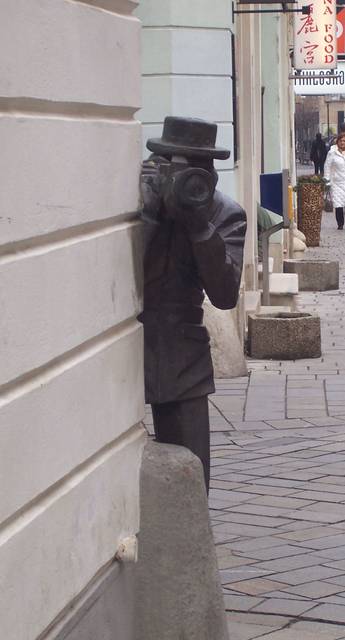
Bryndzové halušky (small, spaetzle-like dumplings with sheep's cheese and topped with pieces of meat) is the national dish of Slovakia and recommended to try. Potent garlic soup (but perhaps not on a date) and Slovak white wine (due to its cooler climate, Slovakia's reds pale in comparison with some of Europe's other offerings), schnitzels, goulashes and other typically Central European foods. Fresh vegetables are more common here thanks to the large amount of land given over to agriculture.
In December, don't miss the Christmas market in front of the Old Town Hall. The traditional foods of the Christmas market are roasted pork or chicken sandwich burgers ("ciganska pecienka") with mustard and onions, potato pancakes ("loksa") with various fillings ranging traditionally from plain ones with goose fat, with garlic or goose liver to poppy seed, nut or chocolate. Bread with pork fat and onions is also popular. Also there are a few stands which offer specialities from other European countries. You can wash down the food with a cup of red or white mulled wine or a small cup of honey wine, also tea with or without rum is available, as well as grog or other "hot mixed drinks" like the Červený medveď (red bear).
Of course, junk food can be found in Bratislava, too. Try Bratislava's special form of junk food - a richman which is a big bread roll filled with cabbage and cheese and/or meat with mayonnaise. Richman stands can be found on Kamenné námestie, in front of the Tesco building, and in Safarikovo square. You can also try a sub sandwich from one of the many cafeterias in the city. Another excellent cafeteria is on Zelená Ulica between Ventúrska Ulica and Hlavné námestie. A big sandwich, a bageta (from the French baguette) with cheese, ham and eggs would cost you about €1.50.
Another specialty in Bratislava (but also available in other regions of Slovakia) is treska. It is a cold salad made of Codfish with mayonnaise. There are vegetables like onions and carrots in the salad too. It has a very distinct taste, somewhere between sour and bitter - you should try it! You can buy it fresh in most "Lahôdky" shops, which means something like "delicacies", but generally stands for old-fashioned fast food shops - they sell salads, soups, etc. instead of hamburgers or French fries. Treska tastes very good with rolls. If you like the taste of Treska, you can also buy it packed to take home.
If you want to self-cater, the largest supermarket near the centre is Tesco on Kamenné námestie (at the junction of Štúrova and Špitálska). You could easily have lunch consisting of a couple of bread rolls, ham, cheese, fruit and maybe a cake or two, for €3-4. New American-type shopping malls with big cinemas and of course food courts within reach of the center are Aupark on the right bank of the Danube (next to Sad Janka Kráľa park, some 10 minutes from St. Martins's Cathedral), Eurovea (next to the old bridge on the old town bank of river, close to the bus station), Polus City Center on Vajnorská Street to the north of the city (some 10–15 minutes from the city by tram) and Bory Mall on the north-western edge of town.
Interestingly, it is rather hard to find a Slovak restaurant among all the Italian, Chinese, Mexican, Indian and other eateries, so if you are looking for a real Slovak meal, head either to the Slovak Pub or the fancy and expensive Slovak Restaurant in Hviezdoslavovo square, the former being the better pick in terms of pricing and atmosphere, the latter in terms of food. A very new addition is the Pressburg restaurant in Michalska street, completing the Slovak trio with prices in the mid-range or slightly above.
Try Prašná Bašta (see below) for tasty meals or Pizza Mizza for the biggest pizza in town.
San Marten is another restaurant with great food and excellent service at affordable prices. For good and reasonably priced halušky, the unique Slovak national meal, visit the Slovak Pub on Obchodna. There are a large number of restaurants in the center of Bratislava in all price ranges so there are plenty to choose from.
- Prasna basta. The best old Pressburger restaurant in town. Just few steps from Michalska street (turn left directly after Michalska tower). Really authentic frequented by locals. With hidden inner garden.
Prasna basta. The best old Pressburger restaurant in town. Just few steps from Michalska street (turn left directly after Michalska tower). Really authentic frequented by locals. With hidden inner garden.
You can get a nice view and can meet some local celebrities at the übercool and very expensive UFO restaurant and disco on top of Nový most bridge.
Try Kofola, a Slovak & Czech soft drink with a similar colour to Coca Cola, but lower in sugar and caffeine (and carbonation). Some places serve "draft Kofola" which indeed is draft from a barrel in a way similar to beer (it used to be co-produced by a Bratislava brewery). Some Slovaks say draft Kofola is even better than the bottled version and that it is best enjoyed outside in the sun, for example after a hike or a bike or rollerblade ride. Kofola is a popular alternative to beer if you want to hang out but don't want to drink alcohol. Vinea is another genuine Slovak soft drink made from grapes, offered both in "white" (green grapes) and "red" varieties (red grapes) and even in a rather sweet and maybe not-so-tasty "soft" version without carbon dioxide.
There are quite a few Slovak beer brands, e.g. Zlatý Bažant, Šariš, Smädný Mních and Topvar. Stein beer is a local Bratislava variety which used to be brewed practically in the city centre. There are three micro-breweries offering beer in Bratislava, Mestiansky Pivovar, Richtar Jakub and Patronka.
If spirits are more your thing, perhaps you will enjoy Slivovica, a fruit-plums brandy of high quality that is associated with Slovakia.
The best pubs offering Slovak beers can be found in the Old Town: Kristian in Michalska street, Bar Parada in Hviezdoslavovo square, or AeroPressoDepresso in Venturska street. All of them are quite cheap (about €1 per half-liter glass of beer).
- Bakchus Vinaren, Hlboka 5, +421 2 3218 6666. A must place for every Bratislava visitor. The best local and Indian dishes in town, purely Slovak wines and historical setting of a traditional wine cellar.
- BeAbout, Presernova 4 (Vajanskeho nabrezie 10, near Safarikovo namestie, +421 948-050107. Su-Th 10:00-00:00, F Sa 10:00-05:00. Music club near the riverside popular with younger crowd. Good selection of beers including Belgian specialty beers.
- Casa del Havana, Michalská 26, +421 910 797 222. 11:00-02:00 mostly. A Cuban-style restaurant and bar near the centre of the Bratislava Old Town. Not very spacious, but has a comfortable terrace. Particularly famous for the mojito, which has been considered the best in Bratislava, if not in all Slovakia. Mojito €6.49.
- GMT Bar. Very nice cocktail menu with waitress service if you can find a table. Ensure you wear a shirt at the weekends!
- UFO. If you want to go for extraordinary, visit UFO. It looks like a cliché flying saucer and it's a high on the SNP Bridge (the member of great-towers.com), and you have to use a lift to go there. There is a good restaurant and lounge bar and observation deck. The view is incomparable.
Bakchus Vinaren, Hlboka 5, +421 2 3218 6666. A must place for every Bratislava visitor. The best local and Indian dishes in town, purely Slovak wines and historical setting of a traditional wine cellar.
BeAbout, Presernova 4 (Vajanskeho nabrezie 10, near Safarikovo namestie, +421 948-050107. Su-Th 10:00-00:00, F Sa 10:00-05:00. Music club near the riverside popular with younger crowd. Good selection of beers including Belgian specialty beers.
Casa del Havana, Michalská 26, +421 910 797 222. 11:00-02:00 mostly. A Cuban-style restaurant and bar near the centre of the Bratislava Old Town. Not very spacious, but has a comfortable terrace. Particularly famous for the mojito, which has been considered the best in Bratislava, if not in all Slovakia. Mojito €6.49.
GMT Bar. Very nice cocktail menu with waitress service if you can find a table. Ensure you wear a shirt at the weekends!
UFO. If you want to go for extraordinary, visit UFO. It looks like a cliché flying saucer and it's a high on the SNP Bridge (the member of great-towers.com), and you have to use a lift to go there. There is a good restaurant and lounge bar and observation deck. The view is incomparable.
Larger clubs in Bratislava include Loft, KC Dunaj, Duplex and SubClub, the latter a former nuclear bunker located under Bratislava Castle. There are many smaller bars with dancefloors closer to the centre, such as Radost on Obchodná Street, next to the Slovak Pub.
Although some cafes are considered gay inclusive, there are at least two bars dedicated to the gay and lesbian crowd in Bratislava, all of them in the city center, close to the Presidential Palace:
- B-Club, Vysoka 14 (at the crossing behind Tatra Banka and Volksbank.
B-Club, Vysoka 14 (at the crossing behind Tatra Banka and Volksbank.
When making international calls, you need to dial 00, then the country code of the country you are calling. The international code of Bratislava is +421 2, the national one is 02. You don't need to use any of these when making local calls. There mostly are cardphones in phone booths, coin phones are located e.g. in front of the telecoms office (T-Centrum) on Namestie SNP (Dunaj department store) or at Kolarska ulica. You can purchase phone cards at most newspaper kiosks and in any of the T-Centers.
Phone numbers beginning with 090, 091, 094 or 095 are mostly mobile numbers. All of Bratislava is covered with a 3G and 4G network, the operators being Orange, T-Mobile and O2. In parts of Bratislava (mostly up on the hills), mobile phones sometimes switch to Hungarian or Austrian providers, so it is better to check the network name before dialing. For best mobile roaming rates, check .
You can use internet for free at the information bureau in the old town.
There are several internet cafes in the city, most of them hidden. You can try to get to one of the internet access portals in the T-Centrum on Namestie SNP or in Aupark Shopping Center.
If you have a notebook computer, you can use multiple wireless hotspots throughout the city. Some of them are paid and you need to obtain a user name and password in order to use them. Some hotels, cafes and restaurants provide free Wi-Fi to their customers. Besides that, the heart of the city center (Hlavné námestie, Františkánske námestie, Primaciálne námestie) is covered by a small public wireless network provided by the city council and this is free to use. There are also other places with free Wi-Fi throughout the city. Free Wi-Fi is also available in most of the new trams, buses and trolleybuses. A full list of these can be found on the website of the Slovak Telecoms Office.
Bratislava is generally very safe by Western standards. It is quite small and the crime rate is low. There is a significant police presence in the city, especially the historical parts, and it is generally not a problem to walk around the city at night. The centre especially is under camera surveillance.
There is very little violent crime in Bratislava. Walking alone after midnight outside of the historical centre is not recommended on Fridays, since you could have an unpleasant encounter with rowdy drunks who could congregate around cheaper establishments. If a problem occurs, you can reach the police on phone number 158. General emergency number (police, fire dept., ambulance) can be reached by dialing 112.
Always ask for printed receipts in establishments to avoid being overcharged. Especially taxi drivers might try to do that. For reference, the usual fare is around €4 around the town, and you shouldn't be charged more than around €10 getting anywhere in Bratislava. Your best bet is to call a taxi dispatch or use one of the mobile apps (see above). Ask around for a recommendation in your hotel/hostel.
On pedestrian crossings without traffic lights, watch out for aggressive drivers. Some of them might not give you the right of way.
- Austria Austrian embassy, Hodžovo námestie 1/A, +421 2 593 015.
- Finland Finland, Palisády 29/A, 4. poschodie, 811 06 Bratislava, +421 2-5980 5111. M-F 09:00-11:30.
- Georgia Georgia, Michalska 9, 811 01 Bratislava 1, +421 2 5464 6484.
- Poland Poland, Paulínyho 7, 814 91 Bratislava, +421 2 59490211.
- United Kingdom United Kingdom, Panská 16, 811 01 Bratislava, +421 2 5998 20 00.
Austria Austrian embassy, Hodžovo námestie 1/A, +421 2 593 015.
Finland Finland, Palisády 29/A, 4. poschodie, 811 06 Bratislava, +421 2-5980 5111. M-F 09:00-11:30.
Georgia Georgia, Michalska 9, 811 01 Bratislava 1, +421 2 5464 6484.
Poland Poland, Paulínyho 7, 814 91 Bratislava, +421 2 59490211.
United Kingdom United Kingdom, Panská 16, 811 01 Bratislava, +421 2 5998 20 00.
- The castle Červený kameň is located about 30 km north-east of Bratislava; it can be reached by bus from Mlynske Nivy bus terminal.
- Do like the locals and hike in the Small Carpathians mountain range. Bratislava lies on the southeast slopes of these mountains. Hiking routes are well indicated.
- Visit the Small Carpathians Wine Region; on the southern slopes of the Small Carpathians there are extensive vineyards and typical wine villages and towns like Rača, Pezinok or Modra. If you are more interested in local wines, follow the Little Carpathians Wine Route.
- Visit Cachtice castle, associated with the blood-thirsty deeds of countess Bathory. It is a large and picturesque ruin set on a hilltop above the small village of Visnove. Take the train north from Bratislava to Nove Mesto nad Vahom (75 minutes), and then change to a small local train for the short journey west to Visnove (15 minutes).
- The Mutěnice Wine Region near the Slovak border in the Czech Republic is well worth a weekend visit. It has some of the best wine in the Czech Republic and many great small cellars to visit. You'll need to take a train to Břeclav and then from there to Hodonín.
- Take the train to Trenčin (one hour and forty minutes), a Slovak town to the north of the capital with a towering hill-top castle and a picturesque old town centre spread out below it.
- The Carnuntum archaeological park is located 25 km from Bratislava, across the Austrian border. The site offers the chance to see the excavations of an ancient Roman city. It is worth a one-day visit together with a stop in the old walled city of Hainburg, the first major town in Austria after crossing the Slovak border.
- Lednice-Valtice in the south-eastern corner of the Czech Republic is a UNESCO World Heritage site containing one of Europe's largest Palacial parklands.
- Senec is a small town 30 km to the west of Bratislava, with the lake resort "Slnečné jazerá" ("Sunny Lakes"). It is a cool place to swim or relax at the beach in the summer months.
- You can use the bus no. 91 of the public transport company of Bratislava (DPB) going to Čunovo in order to cross between Rajka (Hungary) and Bratislava (Slovakia). In Bratislava, the bus has Nový most as its terminus, and near the Hungarian border you get on/off at the stop Čunovské jazerá (you need to signal to the driver if you plan to get off at this stop). From Čunovské jazerá it's a four-kilometer-long straight walk through a flat terrain to the town of Rajka, two kilometers on each side of the border. You may detour to visit a monument at the Austrian-Hungarian-Slovakian three country border.
- The public transport company of Bratislava (DPB) runs a cross-border bus line no. 901 between Hainburg an der Donau (Austria) and Bratislava (Slovakia), with a stop also in the Austrian town of Wolfsthal. In Bratislava, the terminus is the stop Nový most. Note that even though the bus stops at Einsteinova street before crossing the border, it is not possible to alight until reaching Wolfsthal.
- Surrounding major/capital cities Vienna (Austria), Budapest (Hungary), Brno/Prague (Czech Republic) are easily accessible by inter-state buses and trains.
